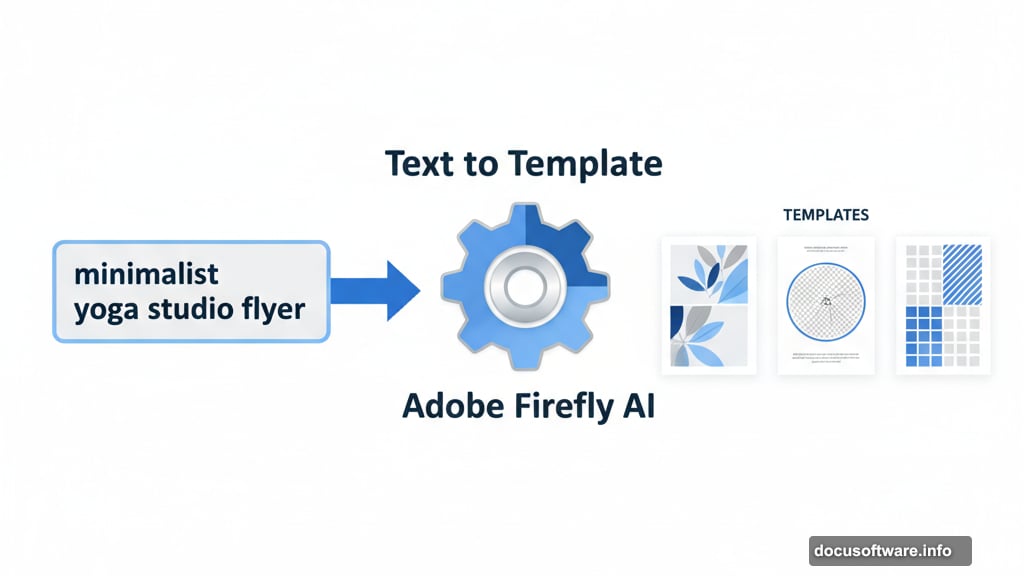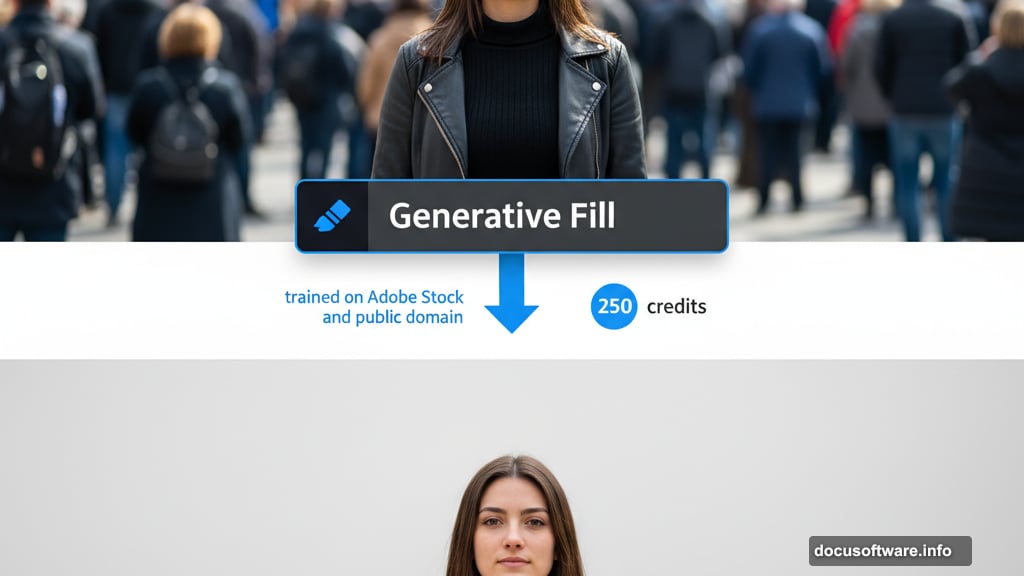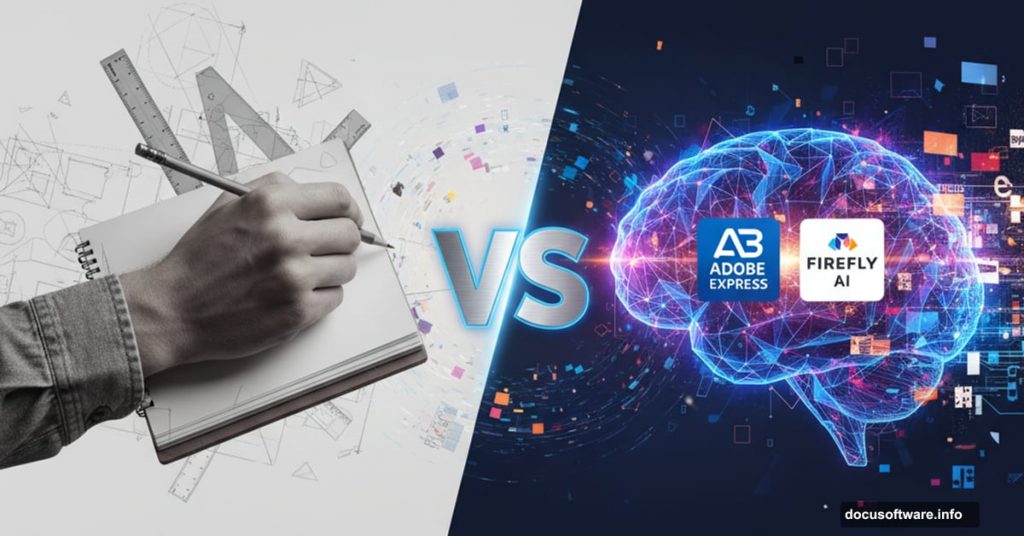Adobe Express evolved from a simple graphics tool into something far more ambitious. Now it wants to be your complete creative partner, powered by generative AI.
I’ve spent months testing this transformation. The question isn’t whether Adobe Express added AI features. Everyone’s doing that. The real question is whether those features actually help you create better content faster, or just add complexity to an already crowded design tool market.
Let’s find out what actually works.
What Adobe Express Actually Does Now
Adobe Express started as Spark, a basic tool for social graphics. That changed dramatically in 2025.
Now it’s a full creative platform. Plus, Adobe baked its Firefly AI model directly into every workflow. So you’re not just using templates anymore. You’re generating original visuals from text prompts, removing backgrounds instantly, and even creating video clips through AI.
The core toolkit remains practical. Quick Actions handle tedious tasks in seconds. Background removal, image resizing, PDF editing—all one-click operations. Meanwhile, the template library offers over 220,000 options on the free plan, expanding to 350,000 with Premium.
But the AI features changed everything. Text to Image generates visuals from descriptions. Generative Fill adds or removes objects from photos. Text to Template creates custom layouts instead of making you search through thousands of options.
Here’s the key difference. Adobe trained Firefly on licensed Adobe Stock content and public domain works. That means fewer copyright concerns compared to AI models trained by scraping random internet content.
The Features That Actually Matter
Skip the marketing hype. These are the tools I use daily.
Generative Fill is the star. Need to remove a distracting element from a client photo? Or add something that wasn’t there? Generative Fill handles it with surprising accuracy. I recently removed an entire background crowd from a restaurant photo and replaced it with something cleaner. The result looked natural, not obviously edited.
Text to Template saves hours. Instead of scrolling through thousands of templates, I describe what I need. “Minimalist yoga studio flyer” generates multiple custom starting points. Then I pick the closest match and customize from there.
Quick Actions handle grunt work. Remove background, resize for multiple platforms, convert to GIF—all instantaneous. I recently adapted one design for Instagram posts, Stories, and Facebook banners in under two minutes.
But there’s a catch. The AI features consume credits. Free plans get a limited monthly allowance. Premium plans offer 250 credits monthly. Generating a 720p video costs 50 credits per second. So you need to plan usage carefully or burn through your allowance fast.

Adobe Express vs Canva: The Real Differences
Everyone asks this question. The answer depends entirely on your specific needs.
Interface and workflow favor Adobe for experienced users. Express keeps layers visible constantly, like Photoshop. That familiarity helps if you’ve used professional design tools. Canva’s interface works better for complete beginners but feels cluttered as you add more features.
AI capabilities differ significantly. Canva’s Magic Studio offers powerful tools. However, Adobe’s Firefly provides two crucial advantages. First, its training data comes from licensed sources, reducing copyright risks. Second, it integrates deeply with Creative Cloud. Pull photos from Lightroom or brand assets from CC Libraries directly into Express projects. Canva can’t match that ecosystem connection.
Pricing actually favors Adobe slightly. Express Premium costs around $9.99 monthly versus $15 for Canva Pro. For teams, the gap widens. Annual Express Teams seats run $79.99 compared to roughly $100 for Canva Teams seats.
So which should you choose? Canva wins for absolute beginners who need maximum hand-holding. Adobe Express wins if you value professional ecosystem integration, commercially safe AI, and slightly lower costs.
Building a Campaign in Under 10 Minutes
Theory means nothing without practice. So I built a complete food truck festival campaign from scratch. My goal: multi-platform assets ready to publish in under 10 minutes.
Step 1 took 90 seconds. I used Text to Template with the prompt “vibrant, modern poster for city food truck festival.” Express generated multiple editable templates instantly. I picked one with bold, energetic design.
Step 2 added personality. I selected the sky area and used Generative Fill with the prompt “drone delivering a taco.” The AI seamlessly integrated that whimsical element, matching lighting and style perfectly. This kind of creative touch previously required significant Photoshop skills.
Step 3 ensured brand consistency. One click applied my saved Brand Kit. Fonts, colors, and logo updated across the entire design automatically. Zero manual effort to maintain brand identity.
Step 4 handled deployment. The Resize Quick Action instantly adapted my poster for Instagram posts, Stories, and Facebook banners. I made minor tweaks to each layout. Then I used the built-in Content Scheduler to plan posts for the entire week.
Total time: 7 minutes, 34 seconds. Complete campaign ready to publish.
Could I do this in Canva? Yes. Would it take longer? Probably. The difference isn’t dramatic, but Adobe’s workflow felt more efficient for this specific use case.
Where Adobe’s Strategy Gets Interesting
Adobe isn’t just building design tools. It’s constructing something bigger.

The company’s vision connects creativity and marketing through a unified AI platform. Express serves as the creative engine feeding content into larger marketing workflows. AI agents orchestrate everything from audience management to content production.
That sounds impressive. But there’s a problem. A recent Morgan Stanley report questioned whether Adobe’s AI promises translate into actual revenue. Monetization has been slower than expected. Plus, competition intensified from Canva, Google, and Meta, all rapidly innovating in this space.
From my testing, Firefly’s video generation shows promise but remains immature. Results sometimes look unconvincing compared to specialized tools. So Adobe’s not invincible in this race.
What This Means for Creators
AI won’t replace designers. But designers who use AI will replace designers who don’t.
For everyday creators, AI democratizes professional-looking content. Small businesses can now produce quality visuals without years of training. That lowers barriers to entry dramatically.
For professional designers and marketers, AI becomes a co-pilot. It automates grunt work, freeing time for strategy, storytelling, and high-level creative direction. One design director told me they use AI “during ideation and concepting phases, saving hours previously spent searching for perfect references.”
The shift is clear. Technical execution matters less. Creative vision and strategic thinking matter more.
The Honest Verdict
Adobe Express succeeded in evolving from simple design app to comprehensive creative platform. It found a compelling position between template-based ease and professional-grade capabilities.
Its value proposition combines three elements. First, robust all-in-one toolkit handling images, video, and PDFs. Second, commercially safe generative AI reducing copyright concerns. Third, seamless Creative Cloud integration for professional workflows.
But it’s not perfect. The free plan offers less than Canva’s free version. AI credits limit heavy generative users. Some newer features still mature. Plus, there’s a slight learning curve for newcomers to Adobe’s ecosystem.
Should you use it? That depends. Solo entrepreneurs designing first logos will find it accessible. Social media managers juggling multiple accounts will appreciate the efficiency. Creative teams needing brand consistency will value the controls.
Adobe Express isn’t just another design tool anymore. It’s a legitimate creative partner, powered by AI that actually helps rather than just adding complexity. The competition remains fierce. But Adobe’s trajectory looks promising.
Your imagination sets the limits. The technology finally caught up.
